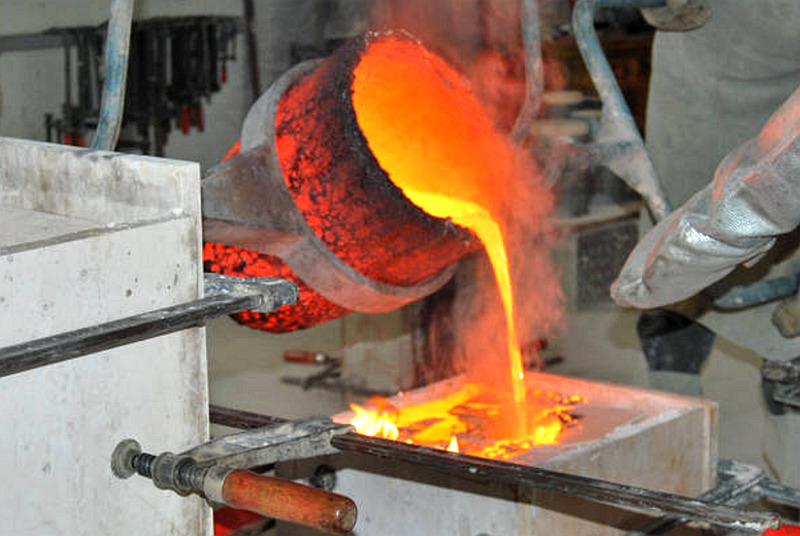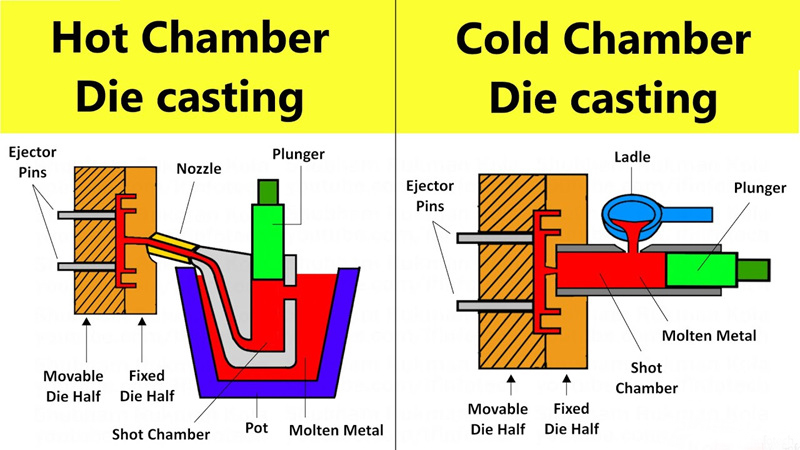Die Casting Machine Adaptation Guide: Comparison of Aluminum And Zinc Alloy Solution Die Casting Pro
LK Die Casting Machine / 2024-12-02 14:13:29
No matter aluminum die-casting machines or zinc die-casting machines have their own advantages. Choosing a suitable die-casting machine according to production needs can improve production efficiency and maximize the utilization of metal solutions.
1) Characteristics of Aluminum Alloy Solution And Zinc Alloy Solution
The density of aluminum is relatively low, about 2.7g/cm³, which makes aluminum die-casting products lighter. The strength of pure aluminum is not very high, but it can be obtained through alloying and proper heat treatment. Aluminum has good thermal conductivity, with a thermal conductivity of about 237W/(m・K). This makes aluminum die-casting products excellent in heat dissipation. Aluminum will naturally form a dense aluminum oxide protective film in the air, preventing the aluminum matrix from further oxidation and corrosion.

The zinc density is about 7.14g/cm³, which is much larger than aluminum, so zinc die-casting products are relatively heavy. This heavier characteristic may have advantages on some occasions where the texture or stability of the product needs to be increased, such as with some high-end door handles, decorative ornaments, etc. The strength of zinc alloy is relatively high, and products with complex shapes and high strength can be manufactured through die casting. Zinc has poorer thermal conductivity than aluminum, but zinc itself has good corrosion resistance. It can form a layer of corrosion product film in the atmospheric environment, which has a certain protective effect on the substrate.
2) The Difference Between Aluminum Die Casting And Zinc Die Casting Process
The melting point of aluminum alloy is relatively high, usually around 600-700℃, which requires the furnace in the die casting equipment to reach and maintain a high temperature, and the refractory material of the furnace needs to be able to withstand such a high temperature. In addition, the fluidity of aluminum alloy liquid is relatively poor, and a higher pressure is required to ensure that it can fill the mold cavity. Due to the high temperature of aluminum alloy die-casting, the mold needs a better cooling system during the die-casting process. Therefore, aluminum alloy die-casting machines are generally equipped with efficient cooling pipes to accurately control the mold temperature through circulating water or other cooling media. Due to the high temperature and high pressure of aluminum alloy die casting, and the relatively complex cooling and demolding, the die-casting cycle is relatively long, and the specific time also depends on the size and complexity of the product.

Zinc alloy has a low melting point, generally between 400-450℃. The lower melting point means that the requirements for the furnace during zinc alloy die casting are relatively low, and the energy consumption is also low. However, due to the low temperature, if the ambient temperature is not properly controlled during the die-casting process, the zinc alloy solution may affect the fluidity due to excessive heat dissipation. The zinc alloy solution has good fluidity and can fill the mold well at a lower pressure. The temperature and pressure of zinc alloy die casting are low, demolding is easy, and the cooling speed is fast, so the die casting cycle is short. Usually, a zinc alloy die casting cycle is about 10-30 seconds, which gives zinc alloy die casting a certain advantage in production efficiency and can produce more products per unit time.
3) Aluminum Die Casting Machine Or Zinc Die Casting Machine?
Generally speaking, cold chamber die casting machines are preferred for aluminum alloy die casting, while hot die casting machines are preferred for zinc alloy die casting, which is related to their characteristics and the configuration of the die casting machine.
The pressure chamber of the cold chamber die-casting machine is not preheated, and the aluminum alloy solution is die-casted only after it is scooped into the pressure chamber. After the aluminum alloy solution is poured into the cold pressure chamber, the aluminum alloy is quickly pressed into the mold cavity through the high-speed movement of the punch. This method can reduce the premature loss of aluminum alloy solution heat and ensure its good fluidity under high pressure.
For zinc alloy die casting, hot chamber die casting machines are more commonly used. Because the melting point of zinc alloy is low, the pressure chamber of the hot chamber die-casting machine can be directly immersed in the zinc alloy furnace, so that the metal liquid can maintain good fluidity in a high-temperature environment. During the die-casting process, the metal liquid can be quickly pressed into the mold cavity under a small pressure through the channel in the pressure chamber, and the die-casting efficiency is high.
4) Application of Aluminum Die-casting Products And Zinc Die-casting Products
Application of aluminum die-casting products:
Automotive industry: used to manufacture cylinder blocks, wheels, and other parts of automobile engines. For example, the wheels of some high-performance cars adopt an aluminum die-casting process, which can not only reduce the weight of the vehicle and improve fuel economy but also ensure the strength and heat dissipation performance of the wheel.
Electronic equipment: such as computer cases, mobile phone cases, etc. The housing of electronic products made of aluminum die-casting can provide good heat dissipation performance is lightweight, and can also obtain a beautiful appearance through surface treatment.
Aerospace field: Some non-critical structural parts adopt an aluminum die-casting process, which can help reduce the weight of aircraft and increase payload by taking advantage of its lightweight and high strength.
Application of zinc die-casting products:
Hardware accessories: such as door handles, locks, etc. Zinc die-casting hardware accessories can obtain good appearance and corrosion resistance through surface treatment processes such as electroplating, meeting the dual requirements of decoration and use.
Small mechanical parts: In some small motors, instruments, and other equipment, zinc die-casting parts can provide sufficient strength and precision, and the cost is relatively low.
Toys and decorations: Zinc die casting can produce toys and decorations with complex shapes and rich details. For example, some exquisite metal toy models can be well restored with design details through a zinc die-casting process, and the appearance and texture are very good.
For more die-casting machine information, please browse our website or contact us by clicking the "Inquiry" button or sending us an e-mail.
OTHER CONTENT
-

2024-09-19 14:16:15 LK Cold Chamber Die Casting Machine DCC900 Locking Force: 9000KN Die Height: 400-1000mm Space Between Tie Bars: 930x930mm Shot Weight: 13.5Kg Casting Area Max:2250c㎡
More -

2024-09-19 14:11:06 LK Cold Chamber Die Casting Machine DCC280 Locking Force: 2800KN Die Height: 250-650mm Space Between Tie Bars: 560x560mm Shot Weight: 2.9Kg Casting Area Max:700c㎡
More -

2024-09-19 10:23:07 LK Cold Chamber Die Casting Machine DCC580 Locking Force: 5000KN Die Heigh: 350-850mm Space Between Tie Bars: 760x760mm Shot Weight: 6.9Kg Casting Area Max:1250c㎡
More -

2024-09-19 10:11:20 LK Cold Chamber Die Casting Machine DCC400 Locking Force: 4000KN Die Height: 300-700mm Space Between Tie Bars: 669x669mm Shot Weight: 4.7Kg Casting Area Max:1000c㎡
More

